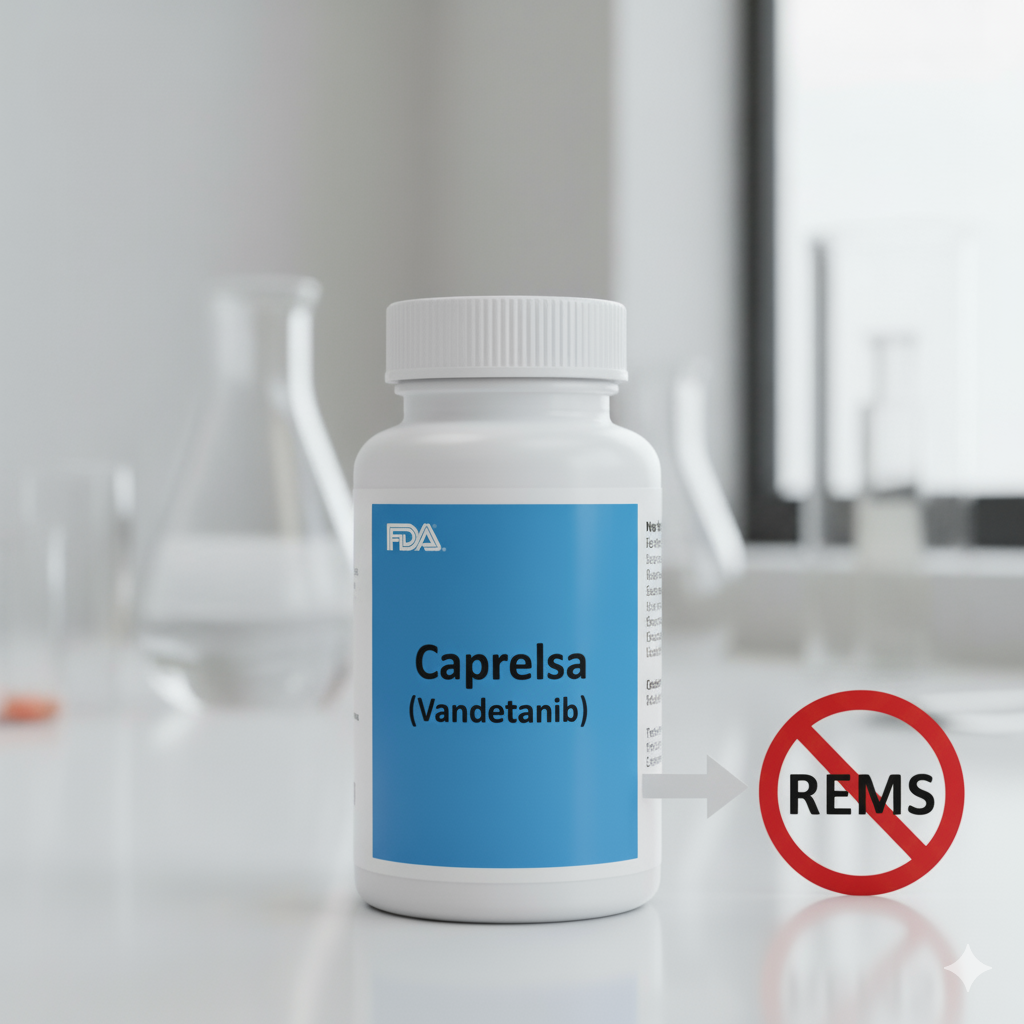Written By: Pallavi Garje BPharm
Reviewed By: Pharmacally Editorial Team
On September 25, 2025, the U.S. Food and Drug Administration (FDA) announced the removal of the Risk Evaluation and Mitigation Strategy (REMS) for Caprelsa (vandetanib). This decision comes after more than a decade of post-market safety monitoring and periodic REMS assessments, which showed that no new of concerning patterns of adverse events related to the drug. The removal of the REMS program does not alter Caprelsa’s boxed warning or the monitoring recommendations described in the prescribing information.
Caprelsa (Vandetanib)
Caprelsa (vandetanib) was first approved by the FDA in 2011 for the treatment of symptomatic or progressive medullary thyroid cancer (MTC) in patients with unresectable locally advanced or metastatic cancer. It remains one of the limited targeted therapies available for this rare and aggressive thyroid malignancy.
Mechanism of Action
Vandetanib is a multikinase inhibitor that blocks several signaling pathways critical for tumor growth and angiogenesis. It inhibits vascular endothelial growth factor receptor (VEGFR), epidermal growth factor receptor (EGFR), and the rearranged during transfection (RET) tyrosine kinase. By simultaneously targeting these pathways, vandetanib suppresses tumor cell proliferation, survival, and angiogenesis, processes that are central to the progression of medullary thyroid carcinoma.
Why REMS Was Originally Required
When vandetanib was first approved in 2011, the FDA identified serious safety concerns related to its effect on cardiac electrophysiology. The drug was shown to cause significant QT interval prolongation, a disturbance in the heart’s electrical activity that can precipitate torsade de pointes, a potentially fatal ventricular arrhythmia, and sudden cardiac death.
Because of this risk, the FDA concluded that routine labeling alone was not sufficient to ensure safe use. A REMS program was therefore mandated to restrict distribution and ensure that only certified prescribers familiar with these risks could prescribe the drug. The REMS also required structured prescriber training and emphasized strict cardiac monitoring.
Patients initiating vandetanib therapy were expected to undergo a baseline electrocardiogram (ECG) prior to treatment, with follow-up ECGs at 2–4 weeks, 8–12 weeks, and then every three months to detect any clinically significant QT prolongation early. In addition, periodic monitoring of electrolytes such as potassium, calcium, and magnesium was required, since abnormalities in these values can further increase the risk of arrhythmias. These precautions were designed to minimize the possibility of fatal cardiac events while allowing patients with advanced medullary thyroid cancer to access the potential benefits of vandetanib.
FDA’s Observations over Time
Since approval of vandetanib, the FDA has been conducting periodic assessments of the REMS program alongside an ongoing review of post-marketing safety data. These evaluations consistently showed that prescribing clinicians were aware of its cardiac risks and were following the recommended monitoring practices. Educational components of the REMS, which included prescriber training and patient counseling, were assessed to have achieved their intended goals, ensuring that both doctors and patients understood the importance of ECG and electrolyte monitoring. Analysis of adverse event reports did not reveal any new or unexpected safety concerns. No emerging pattern of torsades de pointes or unexplained sudden deaths were identified throughout decades of monitoring among U.S. patients treated with vandetanib. Overall this all points reassured agency that the initial risks enacting the REMS had been effectively managed over time.
FDA’s Decision
After reviewing more than a decade of safety data and REMS assessments, the FDA determined that the additional restrictions on vandetanib were no longer necessary to ensure its safe use. The agency emphasized that the primary goals of the REMS that is educating prescribers, ensuring appropriate monitoring, and minimizing the risk of life-threatening arrhythmias had been successfully achieved.
Since no new or concerning patterns of QT-related adverse events were identified, the FDA concluded that healthcare providers are now sufficiently prepared to manage the risks without the administrative requirements of REMS. As a result, in September 2025 the FDA formally lifted the REMS program for Caprelsa (vandetanib), marking a significant regulatory change in how the drug will be accessed and monitored henceforth.
The official press release also clarified that this regulatory step does not alter the existing safety profile of the drug. The black-boxed warning on QT prolongation remains in place, and prescribers are still expected to adhere to the monitoring recommendations outlined in the prescribing information. This action shows FDA has confidence in healthcare providers that they would manage cardiac risk of vandetanib without obligatory burden of REMS.
Future Plan and Ongoing Monitoring
The FDA underlined that removal of the REMS does not mean surveillance ends. Routine post-market pharmacovigilance will continue, and any emerging safety concerns will be evaluated. Prescribers are reminded to continue ECG and electrolyte monitoring as described in the label, adjust doses appropriately in patients with renal impairment, and remain vigilant about drug–drug interactions that may increase QT prolongation risk.
Reference
FDA Removes Risk Evaluation and Mitigation Strategies (REMS) for Caprelsa (vandetanib), News release, US FDA, September 25, 2025 https://www.fda.gov/news-events/press-announcements/fda-removes-risk-evaluation-and-mitigation-strategies-rems-caprelsa-vandetanib



